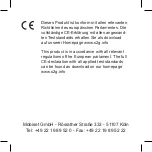
4.
Allow all engine oil to drain from the engine and reinstall the drain plug. Be sure to clean off the
threads on the drain plug before reinstalling into the oil sump. Tighten the plug firmly but do not
overtighten.
5.
Refill the oil with 1.7 quarts (1.6 liters) of engine oil. See Engine Oil Recommendations.
6.
Replace the engine oil fill cap and tighten securely.
7.
Check that the engine oil drain plug is not leaking and has been secured in the oil sump.
8.
Replace the engine oil drain cover back into the generator.
9.
Properly dispose of the used engine oil per local ordinances.
Fig. 14
Maintaining the Battery and Battery Connections
Arcing at the battery terminals, light switches, or other equipment as well as flames or sparks can
ignite battery gas causing severe personal injury. Ventilate the battery area before working on or near
the battery. Wear safety glasses. Do not smoke. Switch the trouble light ON or OFF away from the
battery. Do not disconnect the battery cables while the generator is running or when the vehicle
battery charging system is on. Always disconnect the negative cable first and reconnect it last.
Have the battery charging system serviced if the DC system voltage is consistently low or high.
1. Keep the battery case and terminals clean and dry and the terminals tight.
2. Remove battery cables with a battery terminal puller.
3. Make sure which terminal is positive and which is negative before making battery connections.
Cross wiring the battery terminals will result in severe damage to the generator and RV. To
reduce arcing, always remove the negative battery cable first.
4. Apply battery grease to the battery terminals before securing the generator cables.
Replacing the Spark Plug
The generator has one spark plug, which must be in good condition for proper engine starting and
performance. A spark plug that fouls frequently or has heavy soot deposits indicates the need for
34






































